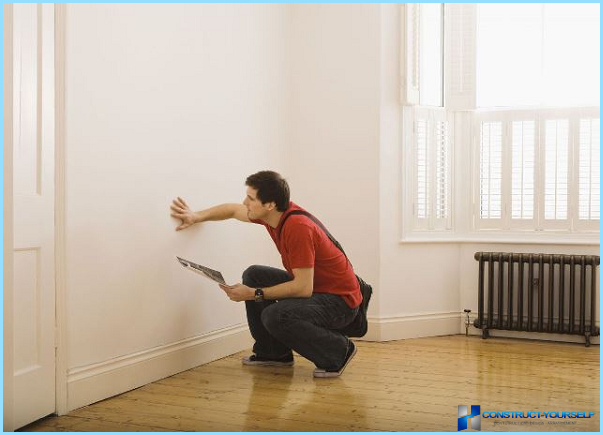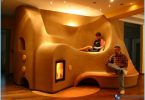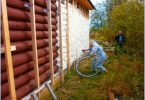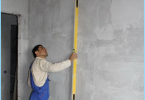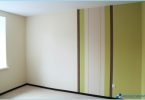The contents
- Properly preparing walls for plaster coating
- The application of wall plaster gypsum based
- How to work with ultra-thin layers of plaster
Before you determine the choice of finishing materials for interior plastering work, carefully examine site of work and decide how much work you can accomplish with your own hands, and that requires honed skills of a professional plasterer. Often invited to withdraw and plaster painting the walls in places curved pair of walls with the ceiling in the most important places in the home.
What can gypsum plaster ↑
The scope of gypsum material, the inner walls dry and well ventilated rooms without a moist atmosphere, capable of delivering on the walls of the condensate or sweat. Most often gypsum mixture for applying finishing coats of plaster, it allows you to get your hands a smooth and sometimes glossy surface, provided that all plastering work carried out correctly in accordance with the recommendations.
Gypsum plaster options there are several features that must properly be taken into account:
- Cannot be used in the plaster pure gypsum or a mixture of alabaster, with chalk, for Amateurs it would be correct to use the dry composition, which has a lot of useful supplements for preventing early setting and shrinkage;
- Simple gypsum compositions do not like wet areas, although there are special versions of solutions with a properly selected polymer additives that increase the resistance of plaster to moisture.
- Gypsum plaster materials to allow to get warm and lightweight plaster, if properly choose components and consistency, you can choose from indoor use of cement-sand mixtures;
- Gypsum is corrosive to steel and aluminium, has an irritant effect on the respiratory system, it is necessary to take into account when working with their hands with mortar and plaster.
This properly prepared plaster plaster weight perfectly adheres even to smooth wall surface.
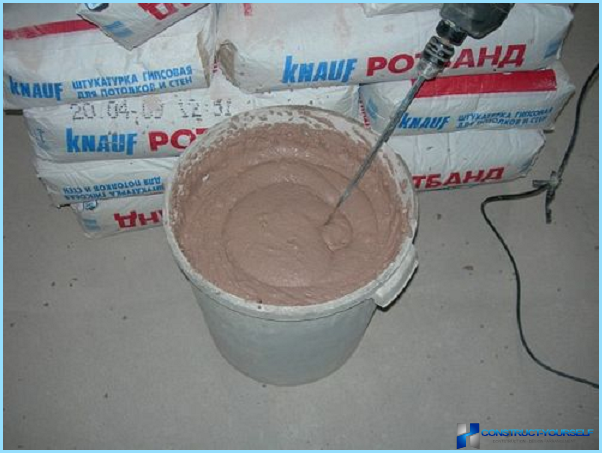
The basics of plastering the walls ↑
Due to the small density, the thickness of the plaster mass can easily reach 5-6 cm even wall surfaces with a negative bias, which is quite problematic for cement-sand mixes. Choosing the right consistency of plaster and primed surface will allow for complex fillet radii on the ceiling in the most remote places. Due to fast hardening plaster, the finish time of the walls with gypsum materials is significantly reduced. Sometimes the plaster composition is applied with only one layer.
Properly preparing walls for plaster coating ↑
To prepare the surface of the walls under the plaster must always. The main objective of the training is the removal of dirt and flying dust, encrusted plaster mass with concrete or brick base. Remove the dust you can with a stiff brush, followed by blowing an air jet.
For particularly important cases (of walls made of basalt or granite stone) are subject to special treatment formulations, ensuring that surface cleaning be performed correctly and efficiently. The composition is sprayed on the surface for 10-15 minutes, removed his hands from the walls along with all the pollution in the form of a thick polymer film.
After cleaning, the walls should be primed with acrylic primer. Properly priming their hands with a brush or roller with a long NAP, but most importantly, the composition of the primer must not run or freeze on the wall with bubbles of air. The primer dries to a tack-free, and gypsum plaster can be applied without fear of its falling off the wall.
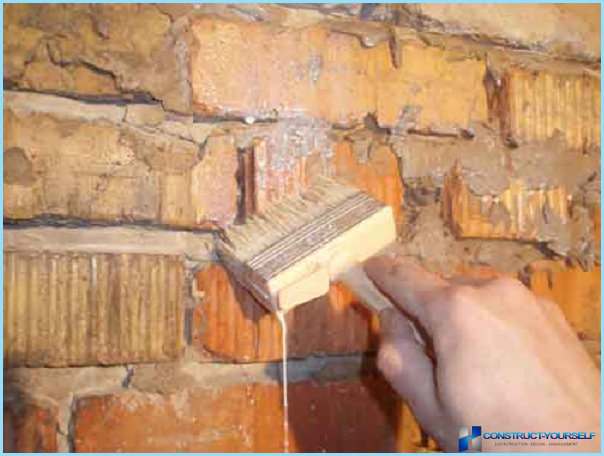
The application of wall plaster gypsum-based ↑
The main problem of any plastering work are always against cracks and the need to correctly align the layers of plaster on the wall surface. Most often the alignment issue solved with the help of right set of landmarks, beacons.
It is a metal or wooden profiles mounted on the sides of the treated surface at a distance slightly less than the length of the main tool of a plasterer – rules. They can be removable or fixed. For a plaster texture more appropriate first option. After plastering the selected section of the vertical profiles are rearranged in the following sector.
If the wall surface is exposed to regular temperature fluctuations, it would be right to divide a plaster composition into two parts. Part of the plaster mass should do a little more liquid, add 1/10 volume of fine quartz sand. A modified part of the plaster applied to the wall first. This will help reduce shrinkage stresses in the contact area, wall and plaster.
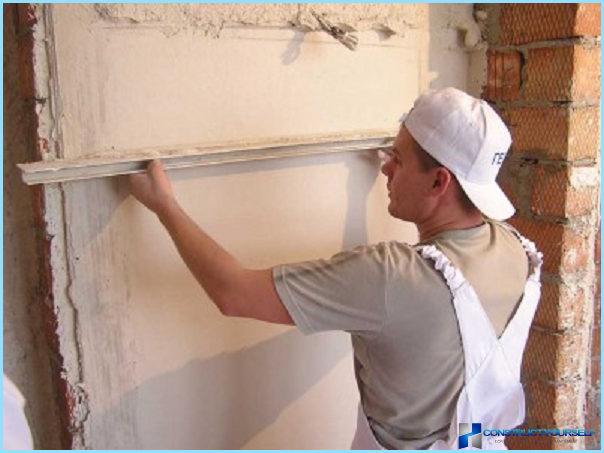
To correctly apply stucco with a trowel or trowel, a throw weight on the wall with some effort to increase the adhesion of the mortar to the surface. But we must remember that the most important is to correctly align and even squeeze a plaster ground plaster so as to form voids and cord. How to apply to the base material with their hands, can be gleaned from the video
After alignment of the gypsum mass comes the rule – long aluminum or wooden rail in 1-1,5 m in length and width 10-15 see Challenge rules – the maximum level the plaster ground plaster, to get a more smooth surface. The time to the correct execution of the work a bit, so the rule starts to work immediately after completion of the spatula.
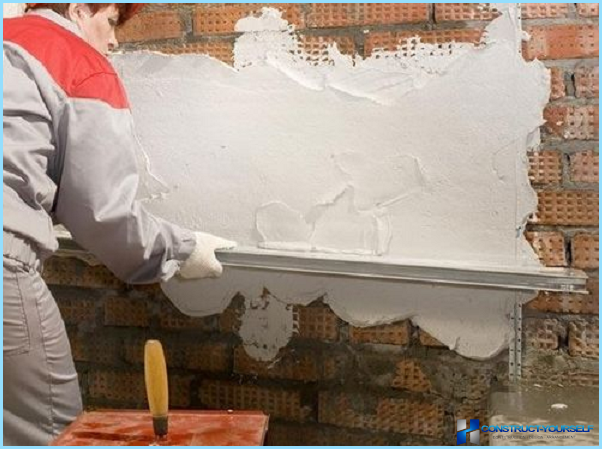
The rule is aligned with the thickness and geometry of the plaster layer, so it rests on the side plates, guiding, trying not so much to cut off excess mortar with how much to dent in the wall. Sometimes technology helps speed the alignment, especially if the material is viscous plaster has started to thicken. The most common method of alignment look at the video
The rubbing surface is float and float – small plates with a smooth working surface. Dipping the tool in firming solution on the working surface of the tool, get a thin liquid film. With the help of the trowel glides over the plaster, leaving a practically smooth surface.
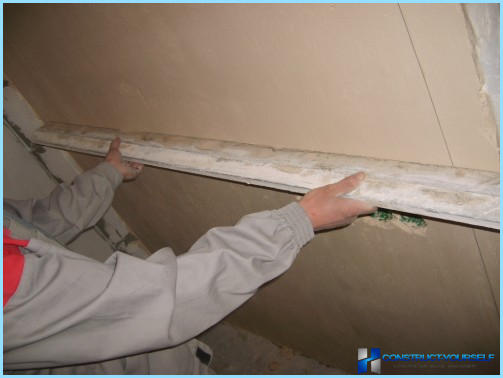
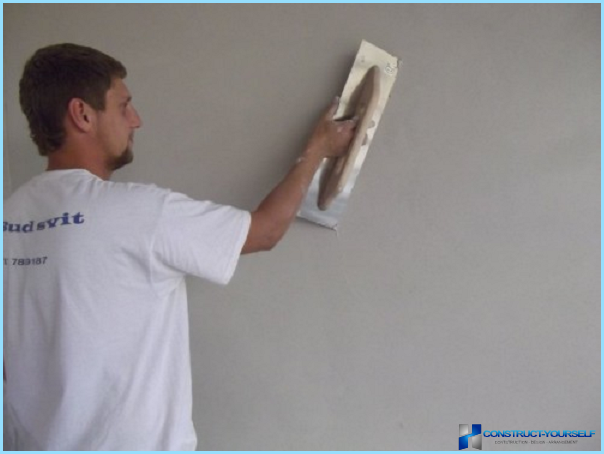
If the tool is even with the application of a solution begins to leave grooves or scratches, most likely, the plaster has already started a local setting in the form of small grains. Air and intense evaporation of moisture from the surface are forced to dry out and thicken the surface layers faster deep. In this case it would be correct to stop processing. All shortcomings and bottlenecks are eliminated with putty after the final setting solution.
Often aligned and smoothed the surface of the plaster suggest to sprinkle dry plaster mixture, similar to cement. Don’t do that, if the layer of material thicker than 10 mm, it can provoke the appearance of local dry areas and the development of a network of microcracks.
How to work with ultra-thin layers of plaster ↑
The thicker the layer of plaster, the easier it is to align the layer and control plane geometry of the applied composition. In some cases, especially in corners or on surfaces with a negative slope of the walls, it is necessary to use a reinforcing insert made of polypropylene mesh.
But it is much harder to work with thin layers of gypsum plaster. Thanks to its good adhesion on the surface of the cement-sand plaster gypsum compositions are often used to repair old walls with cement plaster.
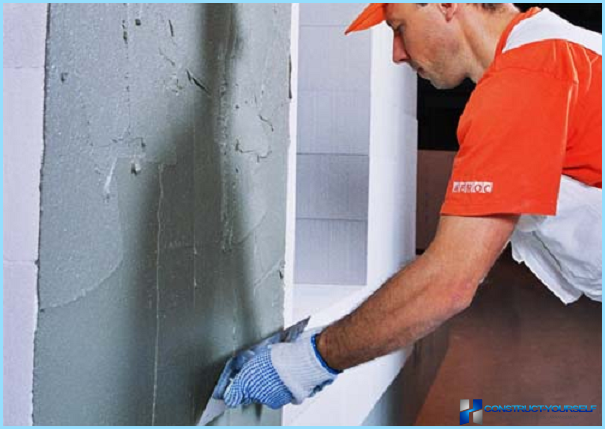
This method requires careful preparation of the coating and correct application of the rules. The main problem is non-linear drying thin layers of gypsum mass. The thinner the layer, the faster it loses its plasticity. Therefore, to align the defects with a plaster mix, if the work quickly and correctly dosing the force pressing the tool to the surface. Upon reaching a certain level of viscosity even finish the compositions with a thickness of 1-2 mm begin to break down.
It is especially difficult to work if the old plaster is replete with cracks and splits. In this case, before the plaster correctly will often make the development of a basic layer of cement based on cement-lime mortar with a further alignment for laying of the gypsum mass.
We have to put up with thicker layers of plaster and to bring their thickness of their hands to the desired value, resorting to machining.
Conclusion ↑
Stucco, if properly used, is the ideal way to align and secure walls. The cost of dry mixes higher than the same cement compositions, but the quality of the finish and the possibility of obtaining «breathable» walls more than compensates for a slight overpayment.

